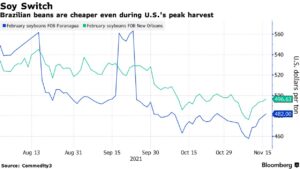As 2026 ushers in a fresh start, agricultural economists say the U.S. farm economy has stopped sliding, but it’s far from fully healed.The December Ag Economists’ Monthly Monitor shows month-to-month…
Biden, Xi Hold Virtual Summit, as Brazilian Soy and Corn from Ukraine in Focus
Wall Street Journal writers Gordon Lubold, Alex Leary and Lingling Wei reported in Tuesday’s paper that, “President Biden and Chinese President Xi Jinping used a virtual meeting Monday evening to cool tensions between the two powers as the leaders seek to manage issues they disagree on and identify ways to communicate to avert conflict.
“During a meeting that lasted more than three hours, both sides sought to tamp down hostilities that have marked the relationship since Mr. Biden took office in January. The White House said the two discussed a range of topics including Afghanistan, North Korea and Iran, as well as human rights, climate change and concerns over Taiwan.
“The discussion didn’t produce any major resolutions, officials said. The White House had sought to manage expectations of the meeting in recent days.”
Demetri Sevastopulo and Tom Mitchell reported this week at The Financial Times Online that, “Aside from Taiwan, the two leaders appeared to agree on the need to ensure that US-China relations, which have fallen to their lowest level in decades, did not spiral further downwards or towards conflict.”
Washington Post writers Seung Min Kim, Ashley Parker, Ellen Nakashima and Lily Kuo reported on Tuesday that, “Trade was raised, and Biden emphasized the need for China to uphold its commitments to buy additional goods from the United States, but it was not a ‘dominant part’ of the conversation, the official said.”
And Bloomberg News reported earlier this week that, “In a statement after the summit, the White House said the leaders ‘discussed the complex nature of relations between our two countries and the importance of managing competition responsibly.’ Biden raised issues including human rights in Hong Kong and Xinjiang, China’s ‘unfair trade and economic practices‘ and the U.S. commitment to Taiwan.”
Reuters writer Mark Weinraub reported on Tuesday that, “A video call on Monday between U.S. President Joe Biden and Chinese counterpart Xi Jinping has also spurred hopes that renewed dialogue could bolster Chinese buying of U.S. soybeans.”
#Soybean Exports Sales.
— Farm Policy (@FarmPolicy) November 15, 2021
--Ag Outlook w/ Chad Hart, complete video: https://t.co/1WeNYeQwaT @AgDecisionMaker, @ISUANR. pic.twitter.com/johoSTJyN7
Also this week, Bloomberg writers Tarso Veloso Ribeiro, Tatiana Freitas, and Alfred Cang reported that,
China is making big purchases of soybeans from Brazil, an unusual move for this time of year.
“The Asian nation needs soybeans to feed its expanding hog herds, and November is a prime time for the U.S. to sell its crops, having just finished the harvest. Supplies are at their peak and American prices should be the most attractive in the world.
“Yet this year, Brazil is even cheaper and cutting into the U.S.’s key sales window. Last week China bought at least 30 soybean cargoes from the U.S. and Brazil, with more than half coming from the South American nation, according to people familiar with the matter. The move shows that Brazil, already the No. 1 shipper, is becoming ever more competitive on world markets.”

Meanwhile, Reuters News reported this week that, “Chinese buyers made substantial purchases of Ukrainian-origin animal feed corn late last week, European traders said on Monday.
“The volumes bought were unclear, with estimates ranging between 300,000 to 700,000 tonnes. One Ukrainian trader said eight to 10 shipments were bought, or at least 500,000 tonnes.”
#Corn Exports Sales.
— Farm Policy (@FarmPolicy) November 15, 2021
--Ag Outlook w/ Chad Hart, complete video: https://t.co/1WeNYeQwaT (@AgDecisionMaker, @ISUANR). pic.twitter.com/TislXUPFeq
The Reuters article indicated that, “‘China still has a corn requirement,’ a trader said. ‘It is strange that China is buying from Ukraine instead of the U.S. where corn prices in C&F terms (including ocean shipping) are lower.’
“‘There is talk China does not like the U.S. system of announcing overseas sales to the market, which can immediately push prices up.'”
Upcoming Marketing Year U.S. Corn Export Commitments
— Farm Policy (@FarmPolicy) November 11, 2021
* #China vs. All Destinations
-- November #Corn & #Soybean Outlook Update https://t.co/kqpJEh8eUZ @PUCommercialAg pic.twitter.com/7iYlAYEqS0
In other developments, Reuters writer Dominique Patton reported earlier this week that, “China has laid out a clear path for seed makers to get approval for genetically modified crops, under proposed rule changes that should lead to commercial cultivation of GM corn.
“Details of the planned regulatory overhaul for the seed industry were published on Friday by the agriculture ministry in a draft document that is open for public comment until Dec. 12.
“The proposed changes mean that a handful of recently approved GM traits developed by Chinese companies could be ready for market launch in a year.”
The article noted that, “Top policymakers have also urged progress in biotech breeding, or GM crops, seen as key to ensuring food security.
“While investing heavily in GM research and development for years, Beijing has remained cautious, barring the planting of GM soybeans or corn, despite allowing imports for use in animal feed.”





